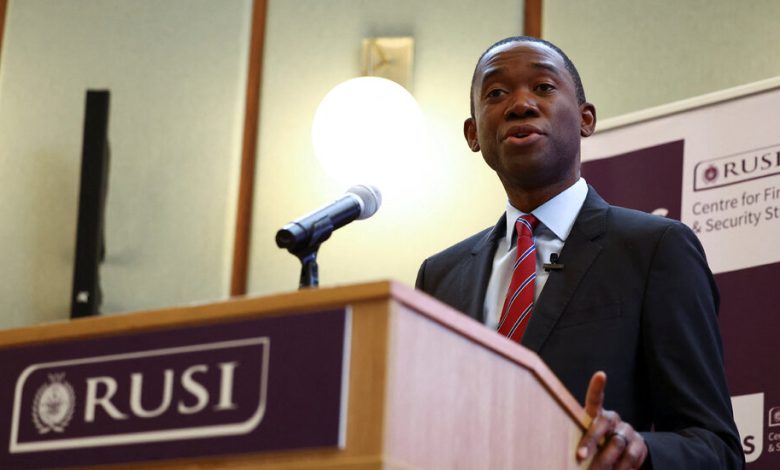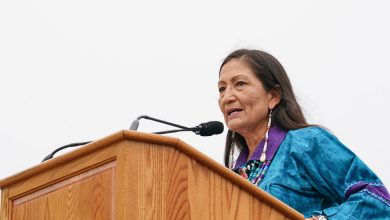Is Crypto Financing Terrorism?

The United States will go after cryptocurrency firms that fail to stop terrorist groups from moving money, the U.S. deputy Treasury secretary, Wally Adeyemo, warned on Friday.
“If they do not act to prevent illicit financial flows” Mr. Adeyemo said in a speech at the Royal United Services Institute in London, “the United States and our partners will.”
Adeyemo’s comments follow a letter by Senator Elizabeth Warren, Democrat of Massachusetts, and dozens of members of Congress this month that called for the Biden administration to crack down on the use of cryptocurrency by terrorists. It cited a report that the terror groups Hamas and Palestinian Islamic Jihad have raised more than $130 million in crypto in recent years.
All of this has set off a raging debate in Washington and the worlds of crypto and finance over how much cryptocurrency is contributing to terrorism.
Elliptic, the firm that provided some of the data for the report, countered in a blog post this week that there was “no evidence to suggest that crypto fund-raising has raised anything close to” the figure cited, and that some of the money included in the total number might have gone to small crypto brokers sometimes designated as terrorist organizations for their role in financing. The analytics firm Chainalysis, which did not provide data for the report, said that when terror funding estimates include all funds to these service providers, they inaccurately assume everything that flows to the service is associated with terrorism.
“Crypto lobbyists are trying to minimize the role of crypto-financed terrorism,” Senator Warren told DealBook, dismissing the pushback. (Elliptic did not respond to a request for comment.)
Because crypto is anonymous, borderless and moves through intermediaries that operate in regulatory gray spaces, critics have for years flagged that it could be used for fund-raising by terrorists. But how realistic is that threat?
The war in Gaza may be driving a rise in crypto fund-raising by terror groups, some authorities say. Tom Alexandrovich, executive director of the Cyber Defense Division at the Israel National Cyber Directorate, has said there is a “super” increase in crypto fund-raising for terror groups as they are being cut off by traditional sources like banks.
Crypto is “a problem” but it is not the main source of funding for Hamas, said Shlomit Wagman, a Harvard scholar and former chair of the Israeli Money Laundering and Terrorism Financing Prohibition Authority, who testified at a Senate Banking Committee hearing on terror financing this week. State actors, like Iran and Turkey, are the main funding drivers for Palestinian terrorist groups, followed by business portfolios with real estate and investments, humanitarian aid and fund-raising, including crypto.
Some aspects of crypto may limit its use by terrorists. The open digital ledgers where crypto transactions are recorded can be (and are) traced to catch bad actors. In April, Hamas’s armed wing announced it would stop Bitcoin fund-raising because the activity was tracked and exposed donors. Yaya J. Fanusie, a former C.I.A. counterterrorism analyst who is now head of the anti-money laundering unit at the industry group Crypto Council for Innovation, told DealBook that a terrorist crypto crowdfunding campaign “is like putting your bank account number on the internet and telling people ‘donate to Hamas here.’”
Members of Congress are calling for more enforcement and legislation. Ms. Warren and other lawmakers have proposed an array of bills that would address crypto terror financing in various ways, including by giving authorities more financial resources to address the threat. The Financial Action Task Force, an international financial regulatory agency with participants from countries around the world, has a regulatory framework for crypto, but many countries have not fully applied it and oversight is often weak, Ms. Wagman said.
The reckoning is overdue, some experts say. Alex Zerden, founder of the risk advisory firm Capitol Peak Strategies and a former official at the Treasury’s Office of Terrorism and Financial Intelligence, told DealBook that debates about the data did not undermine the dawning realization that digital assets are part of this funding picture. “There is no de minimis exception for terror financing, regardless of the medium,” he said.
Senator Cynthia Lummis, Republican of Wyoming and a crypto champion, reached the same conclusion. “Crypto is being used to finance terrorism,” she said at the hearing on Thursday. ”Even one dollar is too much.” — Ephrat Livni
HERE’S WHAT’S HAPPENING
Brisk U.S. economic growth raises questions about more rate raises. Third-quarter G.D.P. data released this week showed the economy growing at its fastest pace in two years, while the Fed’s preferred inflation gauge painted a similar picture of robust consumer spending. The reports came ahead of next week’s Fed meeting, where officials are expected to keep interest rates steady — but leave the door open for increases in the future.
Sam Bankman-Fried testifies in his defense. The head of the collapsed FTX cryptocurrency trading platform, who is accused of using as much as $10 billion in customer deposits to finance lavish spending, said on Friday he did not tell anyone to break any laws.
Ford struck a tentative new contract with the U.A.W. The deal, which must be ratified by union members, would raise wages by 25 percent over four years and bring improvements on job security, pensions and more.
How Adidas tolerated years of misconduct by Kanye West. A New York Times investigation into the sportswear giant’s decade-long partnership with West found numerous instances of the company ignoring antisemitic and sexually offensive remarks to preserve their ties.
Private equity and the pandemic
Joe Nocera and Bethany McLean, both veteran journalists, recently published “The Big Fail,” a book that catalogs the United States’ response to the pandemic, including how changes in business over the 50 years hurt the country’s ability to fight Covid-19. Joe writes about one of those changes, the rise of private equity, below.
In 1980, there were 24 private equity firms, according to Prequin, which tracks alternative assets; by 2022, there were around 5,000 private equity firms controlling some 18,000 companies. Among the industries where private equity sank deep roots was health care. Private equity’s defenders, such the Healthcare Private Equity Association, say that its members are “building strong companies to positively impact health care,” but its critics say there is an irreconcilable conflict between building profits for investors and doing what is best for patients. The nursing home industry, they say, is one of the starkest examples.
Nursing homes cannot easily absorb the debt of a private-equity deal. The model depends on borrowing money to buy a company and then putting the debt on the balance sheet of the acquired company. With nursing homes, the firms often sell the underlying property to a real estate investment trust — forcing nursing homes to pay rent for facilities they had previously owned, while the cash from the sale goes to investors. Nursing homes do not have the ability to expand like a typical company, says Sabrina T. Howell, an economist at New York University who studies private equity, because they derive 70 and 90 percent of revenue from the federal government.
Thin margins have forced many nursing homes to shrink their nursing staff, leaving them ill prepared when the pandemic hit. Ms. Howell was a co-author of a study in 2019 that concluded that private-equity ownership can increase nursing home mortality by 11 percent. One New Jersey analysis found that facilities owned by private equity had a higher rate of Covid-19 deaths and cases than nursing homes not owned by private equity. In New Hampshire, by the end of 2020 one-fifth of all Covid deaths took place in three nursing homes owned by Genesis Healthcare, then controlled by Formation Capital, a private-equity firm narrowly focused on nursing homes.
Most economists who study this problem say the incentives are misaligned. Fewer than 20 percent of all nursing homes meet a recently proposed minimum staffing level, according to a Kaiser Family Foundation estimate. And Mark Parkinson, the chief executive of the American Health Care Association, which represents 14,000 nursing homes, described that proposal as “unfounded, unfunded and unrealistic.”
“Nursing homes are producing a good that we think has an important social function, which is why the government is essentially paying for it,” Ms. Howell said. “And the strategies that lead to maximizing profits are not the strategies that are necessarily in the best interest of taxpayers or the customers.”
Potential doesn’t work how you think it does
The truly great are not necessarily those with the most innate talent, or even those who work hardest, but those with the skills for learning and adapting, says Adam Grant in his latest book, “Hidden Potential: The Science of Achieving Greater Things.” DealBook spoke with Grant, a professor at the Wharton School of the University of Pennsylvania, about why understanding potential is important for business leaders.
The interview has been condensed and edited.
What is the key to spotting potential in job interviews?
Past experience is a terrible predictor of future performance. Like almost entirely useless. Terrible. So I would throw “number of years of experience in a similar role” right out the window.
I would focus much less on somebody’s past level of performance and much more on the slope of their performance. So have they shown significant gains? Have they demonstrated a capacity to overcome adversity?
How does understanding potential change who you promote?
We tend to promote the person in a group that talks the most, that’s called the “Babble Effect.” We’re mistaking their confidence for competence, which it is most definitely not. Let’s try to promote people who are not determined to be the smartest person in the room, but rather want to make the room smarter. So that means actually taking a look at, what is the impact of this person on other people around them? Have they elevated their colleagues, or have they undermined their colleagues?
You write that organizations should be structured as a lattice instead of a ladder. Why?
In a typical organization, the hierarchy is structured like a ladder where if you have an idea, you have to take it up the hierarchy, and all it takes is one boss to say no to kill your idea. In a lattice system, you are given the opportunity to reach out to multiple people at different levels and all you need is one yes to get the green light. And what that does is enhances the collective intelligence of the group. It makes it possible for ideas that have hidden potential, and people who have hidden potential, to water them and grow them, as opposed to just having them ripped out at their roots, so to speak.
Sarah Kessler contributed reporting.
Thanks for reading! We’ll see you Monday.
We’d like your feedback. Please email thoughts and suggestions to [email protected].




